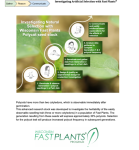High School Biology Investigating Artificial Selection Lesson Plan
View This Resource
This lesson plan, from the University of Wisconsin-Madisons Wisconsin Fast Plants, is for a high school biology investigation into evolution and artificial selection while using Fast Plants polycot seeds. The lesson plan describes student science performance for in-classroom learning as well as distance learning, and assessment for student learning. Additionally, this resource includes a sample calendar to demonstrate how educators can implement this investigation into their classroom. This resource is related to Evidence of Natural Selection Activities and Investigating Selection with New Polycots Fast Plants, which are available to view separately.
Subject
Media Format
Materials Development Era
Resource Type
Language
Audience
Education Level
Creator
Contributor
Source
The Wisconsin Fast Plants Program
Rights
This work by Wisconsin Fast Plants Program is licensed under Attribution-NonCommercial-ShareAlike 4.0 International
Date Issued
August 20th, 2020
Email Address
info@fastplants.org
Classification
NGSS Standard
- NGSS.HS.LS4.4 Construct an explanation based on evidence for how natural selection leads to adaptation of populations. [Clarification Statement: Emphasis is on using data to provide evidence for how specific biotic and abiotic differences in ecosystems (such as ranges of seasonal temperature, long-term climate change, acidity, light, geographic barriers, or evolution of other organisms) contribute to a change in gene frequency over time, leading to adaptation of populations.]
- NGSS.MS.LS4.5 Gather and synthesize information about the technologies that have changed the way humans influence the inheritance of desired traits in organisms. [Clarification Statement: Emphasis is on synthesizing information from reliable sources about the influence of humans on genetic outcomes in artificial selection (such as genetic modification, animal husbandry, gene therapy); and, on the impacts these technologies have on society as well as the technologies leading to these scientific discoveries.]
- NGSS.MS.LS4.6 Use mathematical representations to support explanations of how natural selection may lead to increases and decreases of specific traits in populations over time. [Clarification Statement: Emphasis is on using mathematical models, probability statements, and proportional reasoning to support explanations of trends in changes to populations over time.] [Assessment Boundary: Assessment does not include Hardy Weinberg calculations.]

Comments